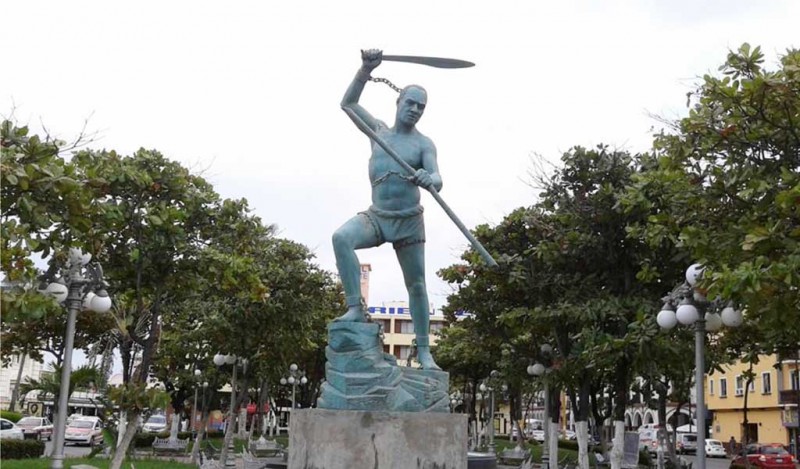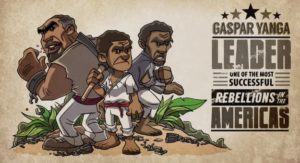By: Alexia Rodríguez, Kylie Lieblang, and Adriana Tellechea from Instituto Lizardi High School in Zihuatanejo, Guerrero, Mexico*
Yanga -One of the First Black Liberators in the Americas
Mexico and its people have always been motivated by freedom and the overall well-being of the community.
With the evolution of its history and multiple beacons of success, Mexico´s freedom has been the nation’s focus for many centuries.
Mexico’s fight for freedom started with its independence from Spain in 1810, and then the country fought again in 1910 during the Mexican Revolution. But, this struggle for freedom dates back further to 1570 when there was an African slave revolution against what was then, “New Spain”.
Slavery in the “New Spain” Colony – Now Called Mexico
Slavery in “New Spain,” which is now Mexico, was mostly focused on the use of Africans for agricultural and service purposes. Sugar plantations in the coastal state of Veracruz had the most concentration of enslaved people brought from several parts of the African continent. After Africans arrived in Mexico, they were immediately introduced to different plantations and other work environments, with scarce provisions and no rights or basic human needs.
During these times of desperation, a particular individual stood out as one of the most important founders of one of the very first fights for the abolition of slavery ever recorded but unfortunately forgotten – YANGA.
Yanga of Veracruz Led a Revolt Against Slavery in 1570
He was a Prince!
Yanga was one of the first black liberators in the Americas. He led one of the most successful slave rebellions. Yanga was born in 1545 in West Africa and was a member of the royal family of Africa’s Gabon. He was an African prince!
Yanga was one of the many enslaved people brought over from West Africa and forced to work in the Spanish sugar plantations in New Spain (Mexico).
By: Black History Heroes.com
He Built a Colony of African Descendents
In 1570, Yanga led a slave revolt and escaped with a group of followers into the mountainous terrain surrounding Veracruz. They went to a place called Pico de Orizaba or Star Mountain which is the highest mountain in Mexico.
Yanga and his people built a small marooned colony. These colonies were called maroons because they were made up of African runaways who escaped from slavery in the Americas and formed independent settlements or joined with the indigenous people. Yanga’s colony was called San Lorenzo de Los Negros, but in 1932, the town changed its name to Yanga.
Yanga and his people survived more than 30 years through farming. They also waged a campaign against Spanish colonial rule, raiding caravans that carried goods and other supplies between Veracruz and Mexico City.
Yanga’s raids and the ongoing movement of black and indigenous slaves to his community upset the Spanish plantation owners, so they called on the colonial government to take action. The Spanish authorities decided to take control of this territory again in 1606.
Yanga Negotiated and Won a “Free Area” from Spain
Yanga asked the Spanish for an agreement with terms that included a free area only for Yanga’s group and, in compensation, they would fight in support of the Spanish in case of any conflict against them. But the Spanish did not accept the terms and decided to begin a battle against Yanga’s group that ended up with several losses on both sides and, they could not claim victory. Finally, the Spanish had no other choice than to accept the terms laid by Yanga.
Yanga is Recognized as a National Hero
Five decades later in 1860, after the Mexican independence, Yanga was recognized as a hero of Mexico thanks to Vicente Riva Palacio, the grandson of the Afro-Mexican President Vicente Guerrero, who gathered the first information about him.
This painting by Aydee Rodriquez, a renowned artist from the Costa Chica area depicts Yanga with the chains of slavery, a sword for the fight for freedom, and a book for education and liberty.
Now, every August 10th the population of this town celebrates El Carnaval de la Negritude in commemoration of Yanga’s legacy. People celebrate and appreciate their freedom in Yanga’s town.
Look at this video from Black History Heroes.com.
*Editor’s Note: Alexia Rodríguez, Kylie Lieblang, and Adriana Tellechea are now graduates of Instituto Lizardi in Zihuatanejo, Guerrero, Mexico. This article was written as part of their final examination for an English writing class taught by the editor of this publication.
Related Article:
References:
Yanga and Blacks in Mexico: 1570 African Slave Revolt in Veracruz. Recovered from http://www.blackhistoryheroes.com/2011/05/gaspar-yanga-1570-african-slave-revolt.html?m=1
Jiménez, A. (August 2nd, 2004). Yanga, símbolo de negritud y libertad. La Jornada. Recovered from http://www.jornada.unam.mx/2004/08/02/052n1con.php?printver=1&fly=



